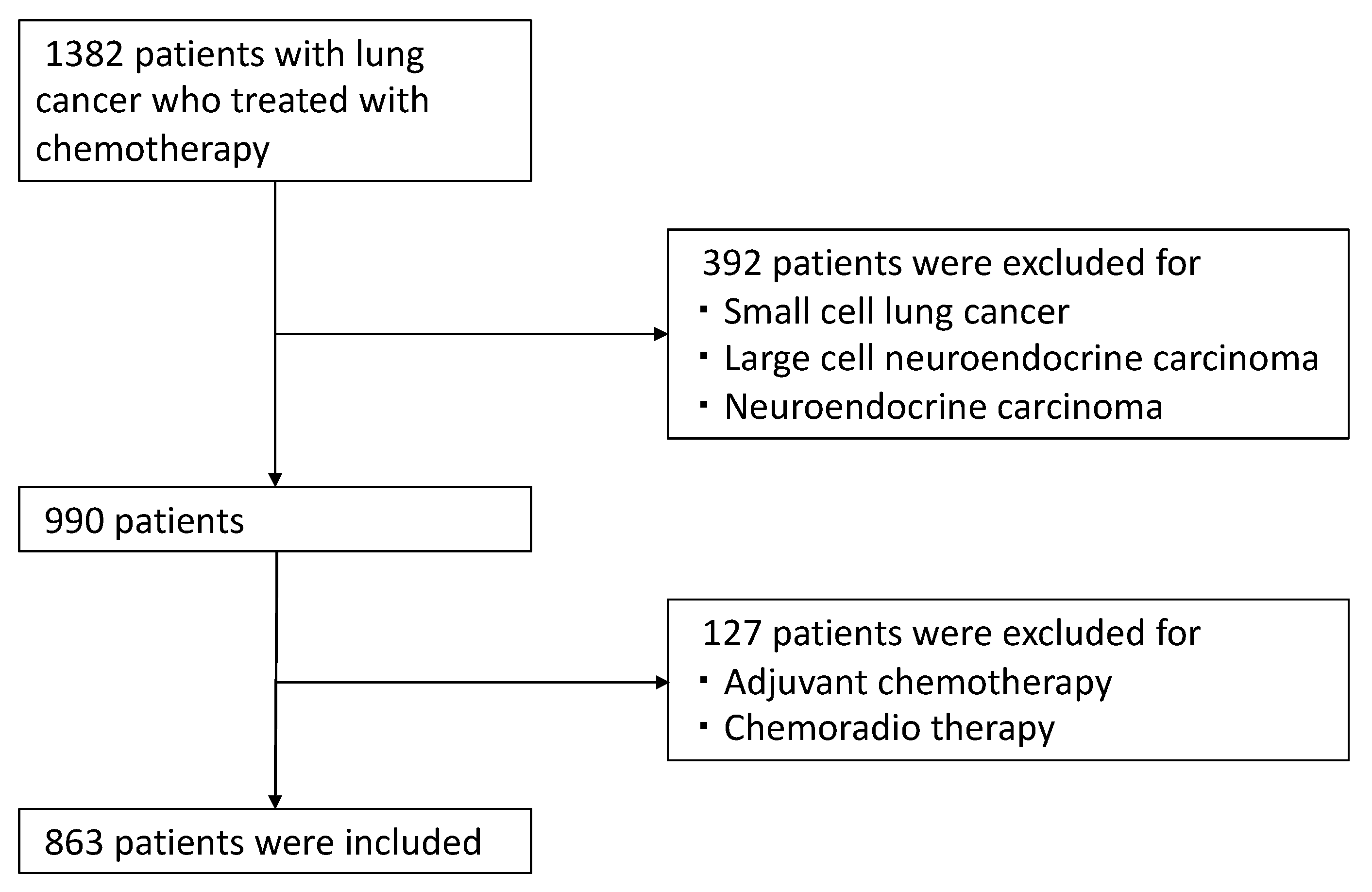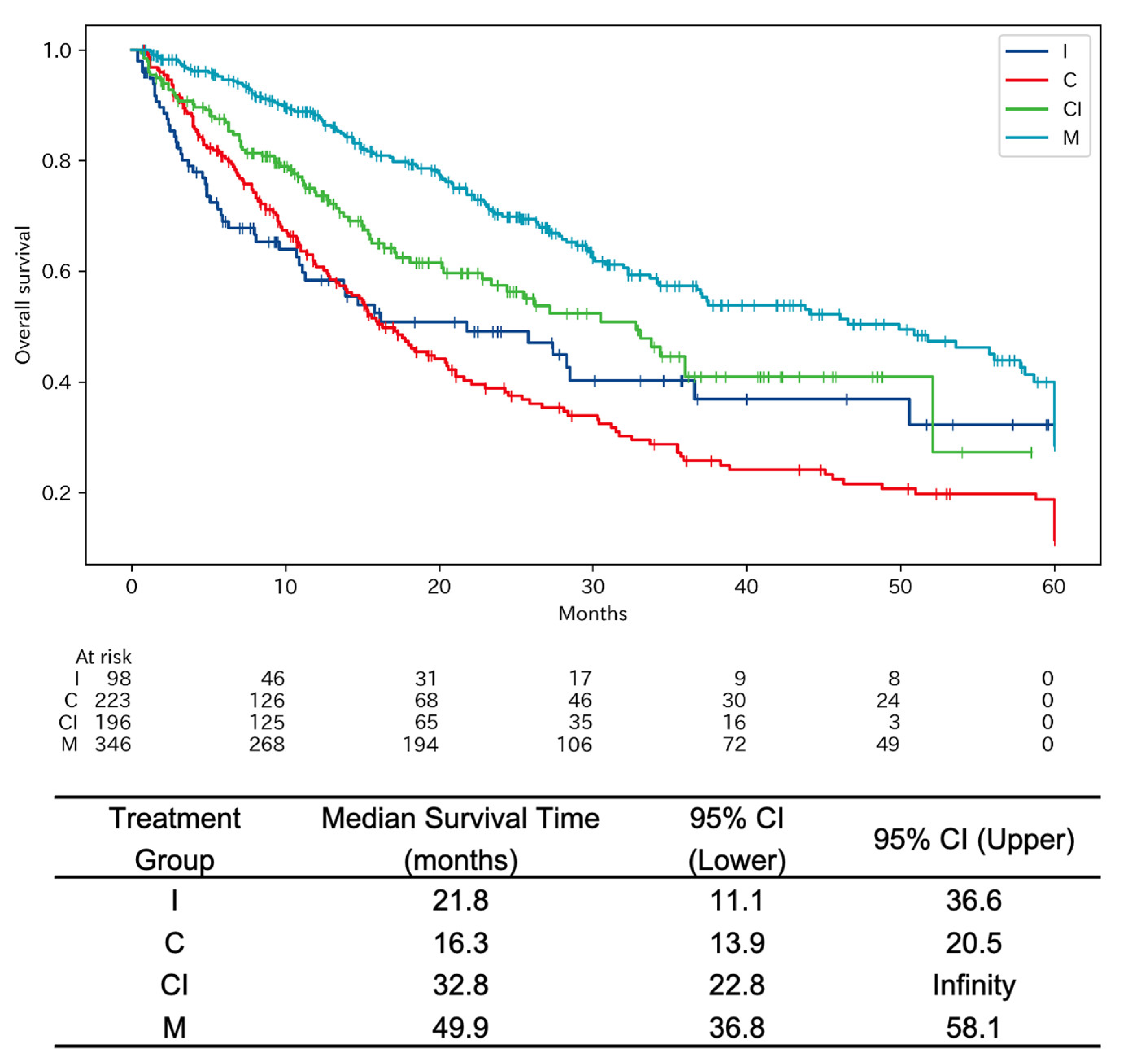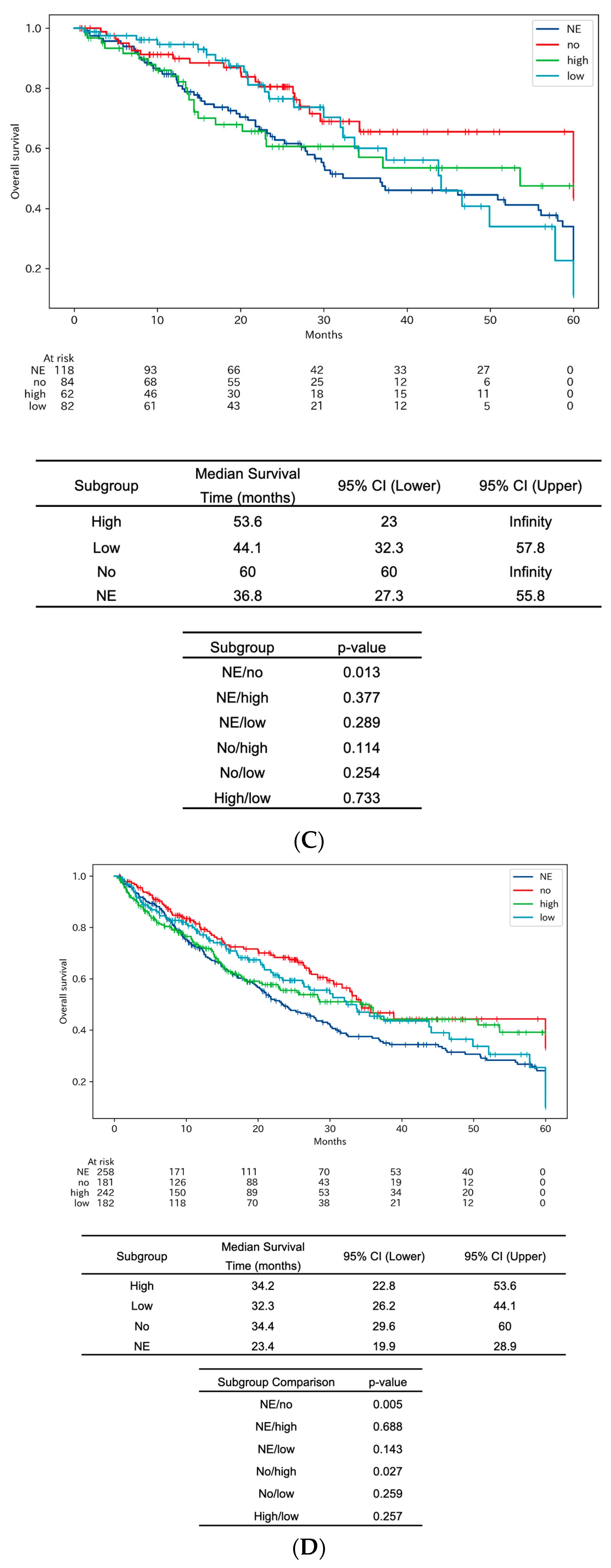Tailoring Therapeutic Strategies in Non-Small-Cell Lung Cancer: The Role of Genetic Mutations and Programmed Death Ligand-1 Expression in Survival Outcomes
Abstract
:Simple Summary
Abstract
1. Introduction
2. Materials and Methods
2.1. Study Design
2.2. Study Population
2.3. Molecular and Immunohistochemical Analyses
2.4. Statistical Analysis
3. Results
3.1. Impact of Molecular Targeted Agents and Immune Checkpoint Inhinitors
3.1.1. Patient Characteristics
3.1.2. Overall Survival among Patients Treated with Different Systemic Anticancer Treatments
3.2. Impact of Driver Oncogene Mutation and Molecular Targeted Agents
3.2.1. Prevalence of Driver Oncogene Mutations in the Cohort
3.2.2. Comparative Analysis of Diagnostic Methodologies for Detecting Driver Oncogene Mutations in NSCLC
3.2.3. Overall Survival following Molecular Targeted Therapy Based on Driver Oncogene Mutations
3.2.4. Overall Survival among Patients without Driver Oncogene Mutations or Unevaluated for Mutations after Initiation of Cytotoxic Agents with or without Immune Checkpoint Inhibitors
3.3. Impact of Expession of PD-L1 and Immune Checkpoint Inhibitors
3.3.1. Overall Survival Stratified by PD-L1 Expression Levels in NSCLC Patients
3.3.2. Multivariate Analysis of Factors Affecting Overall Survival in NSCLC Patients
4. Discussion
5. Conclusions
Author Contributions
Funding
Institutional Review Board Statement
Informed Consent Statement
Data Availability Statement
Conflicts of Interest
References
- Sung, H.; Ferlay, J.; Siegel, R.L.; Laversanne, M.; Soerjomataram, I.; Jemal, A. Global Cancer Statistics 2020: GLOBOCAN Estimates of Incidence and Mortality Worldwide for 36 Cancers in 185 Countries. CA Cancer J. Clin. 2021, 71, 209–249. [Google Scholar] [CrossRef]
- Sher, T.; Dy, G.K.; Adjei, A.A. Small Cell Lung Cancer. Mayo Clin Proc. 2008, 83, 355–367. [Google Scholar] [CrossRef]
- Zappa, C.; Mousa, S.A. Non-small cell lung cancer: Current treatment and future advances. Transl. Lung Cancer Res. 2016, 5, 288–300. [Google Scholar] [CrossRef]
- Chen, R.; Manochakian, R.; James, L.; Azzouqa, A.-G.; Shi, H.; Zhang, Y.; Zhao, Y.; Zhou, K.; Lou, Y. Emerging therapeutic agents for advanced non-small cell lung cancer. J. Hematol. Oncol. 2020, 13, 58. [Google Scholar] [CrossRef] [PubMed]
- Mok, T.S.; Wu, Y.-L.; Thongprasert, S.; Yang, C.-H.; Chu, D.-T.; Saijo, N.; Sunpaweravong, P.; Han, B.; Margono, B.; Ichinose, Y.; et al. Gefitinib or Carboplatin–Paclitaxel in Pulmonary Adenocarcinoma. N. Engl. J. Med. 2009, 361, 947–957. [Google Scholar] [CrossRef] [PubMed]
- Ramalingam, S.S.; Vansteenkiste, J.; Planchard, D.; Cho, B.C.; Gray, J.E.; Ohe, Y.; Zhou, C.; Reungwetwattana, T.; Cheng, Y.; Chewaskulyong, B.; et al. Overall Survival with Osimertinib in Untreated, EGFR-Mutated Advanced NSCLC. N. Engl. J. Med. 2020, 382, 41–50. [Google Scholar] [CrossRef] [PubMed]
- Popat, S. Osimertinib as First-Line Treatment in EGFR-Mutated Non–Small-Cell Lung Cancer. N. Engl. J. Med. 2018, 378, 192–193. [Google Scholar] [CrossRef]
- Maemondo, M.; Inoue, A.; Kobayashi, K.; Sugawara, S.; Oizumi, S.; Isobe, H.; Gemma, A.; Harada, M.; Yoshizawa, H.; Kinoshita, I.; et al. Gefitinib or Chemotherapy for Non–Small-Cell Lung Cancer with Mutated EGFR. N. Engl. J. Med. 2010, 362, 2380–2388. [Google Scholar] [CrossRef] [PubMed]
- Zia, V.; Lengyel, C.G.; Tajima, C.C.; de Mello, R.A. Advancements of ALK inhibition of non-small cell lung cancer: A literature review. Transl. Lung Cancer Res. 2023, 12, 1563–1574. [Google Scholar] [CrossRef]
- Pennell, N.A.; Arcila, M.E.; Gandara, D.R.; West, H. Biomarker Testing for Patients with Advanced Non–Small Cell Lung Cancer: Real-World Issues and Tough Choices. Am. Soc. Clin. Oncol. Educ. Book 2019, 39, 531–542. [Google Scholar] [CrossRef]
- Reungwetwattana, T.; Liang, Y.; Zhu, V.; Ou, S.-H.I. The race to target MET exon 14 skipping alterations in non-small cell lung cancer: The Why, the How, the Who, the Unknown, and the Inevitable. Lung Cancer 2017, 103, 27–37. [Google Scholar] [CrossRef]
- Subbiah, V.; Velcheti, V.; Tuch, B.; Ebata, K.; Busaidy, N.; Cabanillas, M.; Wirth, L.; Stock, S.; Smith, S.; Lauriault, V.; et al. Selective RET kinase inhibition for patients with RET-altered cancers. Ann. Oncol. 2018, 29, 1869–1876. [Google Scholar] [CrossRef]
- Seidel, J.A.; Otsuka, A.; Kabashima, K. Anti-PD-1 and Anti-CTLA-4 Therapies in Cancer: Mechanisms of Action, Efficacy, and Limitations. Front. Oncol. 2018, 8, 86. [Google Scholar] [CrossRef] [PubMed]
- Shiravand, Y.; Khodadadi, F.; Kashani, S.M.A.; Hosseini-Fard, S.R.; Hosseini, S.; Sadeghirad, H.; Ladwa, R.; O’byrne, K.; Kulasinghe, A. Immune Checkpoint Inhibitors in Cancer Therapy. Curr. Oncol. 2022, 29, 3044–3060. [Google Scholar] [CrossRef]
- Sanborn, R.E.; Schneiders, F.L.; Senan, S.; Gadgeel, S.M. Beyond Checkpoint Inhibitors: Enhancing Antitumor Immune Response in Lung Cancer. Am. Soc. Clin. Oncol. Educ. Book 2022, 42, 673–686. [Google Scholar] [CrossRef]
- Danesi, V.; Massa, I.; Foca, F.; Delmonte, A.; Crinò, L.; Bronte, G.; Ragonesi, M.; Maltoni, R.; Manunta, S.; Cravero, P.; et al. Real-World Outcomes and Treatments Patterns Prior and after the Introduction of First-Line Immunotherapy for the Treatment of Metastatic Non-Small Cell Lung Cancer. Cancers 2022, 14, 4481. [Google Scholar] [CrossRef] [PubMed]
- Lee, D.H.; Tsao, M.-S.; Kambartel, K.-O.; Isobe, H.; Huang, M.-S.; Barrios, C.H.; Khattak, A.; de Marinis, F.; Kothari, S.; Arunachalam, A.; et al. Molecular testing and treatment patterns for patients with advanced non-small cell lung cancer: PIvOTAL observational study. PLoS ONE 2018, 13, e0202865. [Google Scholar] [CrossRef] [PubMed]
- Sharma, N.; Graziano, S. Overview of the LUX-Lung clinical trial program of afatinib for non-small cell lung cancer. Cancer Treat. Rev. 2018, 69, 143–151. [Google Scholar] [CrossRef]
- Shaw, A.T.; Bauer, T.M.; de Marinis, F.; Felip, E.; Goto, Y.; Liu, G.; Mazieres, J.; Kim, D.-W.; Mok, T.; Polli, A.; et al. First-Line Lorlatinib or Crizotinib in Advanced ALK-Positive Lung Cancer. N. Engl. J. Med. 2020, 383, 2018–2029. [Google Scholar] [CrossRef]
- Camidge, D.R.; Kim, H.R.; Ahn, M.-J.; Yang, J.C.H.; Han, J.-Y.; Hochmair, M.J.; Lee, K.H.; Delmonte, A.; Campelo, M.R.G.; Kim, D.-W.; et al. Brigatinib Versus Crizotinib in Advanced ALK Inhibitor–Naive ALK-Positive Non–Small Cell Lung Cancer: Second Interim Analysis of the Phase III ALTA-1L Trial. J. Clin. Oncol. 2020, 38, 3592–3603. [Google Scholar] [CrossRef]
- Peters, S.; Camidge, D.R.; Shaw, A.T.; Gadgeel, S.; Ahn, J.S.; Kim, D.W.; Ou, S.H.; Pérol, M.; Dziadziuszko, R.; Rosell, R.; et al. Alectinib versus Crizotinib in Untreated ALK -Positive Non–Small-Cell Lung Cancer. N. Engl. J. Med. 2017, 31, 829–838. [Google Scholar] [CrossRef] [PubMed]
- Shaw, A.; Riely, G.; Bang, Y.-J.; Kim, D.-W.; Camidge, D.; Solomon, B.; Varella-Garcia, M.; Iafrate, A.; Shapiro, G.; Usari, T.; et al. Crizotinib in ROS1-rearranged advanced non-small-cell lung cancer (NSCLC): Updated results, including overall survival, from PROFILE 1001. Ann. Oncol. 2019, 30, 1121–1126. [Google Scholar] [CrossRef]
- Johnson, B.E.; Baik, C.S.; Mazieres, J.; Groen, H.J.; Melosky, B.; Wolf, J.; Kolaei, F.A.Z.V.; Wu, W.-H.; Knoll, S.; Dawson, M.K.; et al. Clinical Outcomes with Dabrafenib Plus Trametinib in a Clinical Trial Versus Real-World Standard of Care in Patients with BRAF-Mutated Advanced NSCLC. JTO Clin. Res. Rep. 2022, 3, 100324. [Google Scholar] [CrossRef]
- Jiang, Y.; Shi, Y.; Liu, Y.; Wang, Z.; Ma, Y.; Shi, X.; Lu, L.; Wang, Z.; Li, H.; Zhang, Y.; et al. Efficacy and safety of alectinib in ALK-positive non-small cell lung cancer and blood markers for prognosis and efficacy: A retrospective cohort study. Transl. Lung Cancer Res. 2022, 11, 2521–2538. [Google Scholar] [CrossRef]
- Schmid, S.; Cheng, S.; Chotai, S.; Garcia, M.; Zhan, L.; Hueniken, K.; Balaratnam, K.; Khan, K.; Patel, D.; Grant, B.; et al. Real-World Treatment Sequencing, Toxicities, Health Utilities, and Survival Outcomes in Patients with Advanced ALK-Rearranged Non-Small-Cell Lung Cancer. Clin. Lung Cancer 2023, 24, 40–50. [Google Scholar] [CrossRef] [PubMed]
- Li, Y.; Appius, A.; Pattipaka, T.; Feyereislova, A.; Cassidy, A.; Ganti, A.K. Real-world management of patients with epidermal growth factor receptor (EGFR) mutation-positive non–small-cell lung cancer in the USA. PLoS ONE 2019, 14, e0209709. [Google Scholar]
- Okamoto, I.; Morita, S.; Tashiro, N.; Imamura, F.; Inoue, A.; Seto, T.; Yamamoto, N.; Ohe, Y.; Nakagawa, K.; Fukuoka, M. Real world treatment and outcomes in EGFR mutation-positive non-small cell lung cancer: Long-term follow-up of a large patient cohort. Lung Cancer 2018, 117, 14–19. [Google Scholar] [CrossRef]
- Kobayashi, N.; Katakura, S.; Kamimaki, C.; Somekawa, K.; Fukuda, N.; Tanaka, K.; Watanabe, K.; Horita, N.; Hara, Y.; Piao, H.; et al. Resistance mechanisms of epidermal growth factor receptor tyrosine kinase inhibitors in non-small cell lung cancer patients: A meta-analysis. Thorac. Cancer 2021, 12, 1096–1105. [Google Scholar] [CrossRef]
- Leonetti, A.; Sharma, S.; Minari, R.; Perego, P.; Giovannetti, E.; Tiseo, M. Resistance mechanisms to osimertinib in EGFR-mutated non-small cell lung cancer. Br. J. Cancer 2019, 121, 725–737. [Google Scholar] [CrossRef]
- Cooper, A.J.; Sequist, L.V.; Lin, J.J. Third-generation EGFR and ALK inhibitors: Mechanisms of resistance and management. Nat. Rev. Clin. Oncol. 2022, 19, 499–514. [Google Scholar] [CrossRef] [PubMed]
- Gainor, J.F.; Dardaei, L.; Yoda, S.; Friboulet, L.; Leshchiner, I.; Katayama, R.; Dagogo-Jack, I.; Gadgeel, S.; Schultz, K.; Singh, M.; et al. Molecular Mechanisms of Resistance to First- and Second-Generation ALK Inhibitors in ALK -Rearranged Lung Cancer. Cancer Discov. 2016, 6, 1118–1133. [Google Scholar] [CrossRef]
- Zhong, J.; Bai, H.; Wang, Z.; Duan, J.; Zhuang, W.; Wang, D.; Wan, R.; Xu, J.; Fei, K.; Ma, Z.; et al. Treatment of advanced non-small cell lung cancer with driver mutations: Current applications and future directions. Front. Med. 2023, 17, 18–42. [Google Scholar] [CrossRef]
- Fu, K.; Xie, F.; Wang, F.; Fu, L. Therapeutic strategies for EGFR-mutated non-small cell lung cancer patients with osimertinib resistance. J. Hematol. Oncol. 2022, 15, 1–32. [Google Scholar] [CrossRef]
- Shimizu, J.; Masago, K.; Saito, H.; Nishino, K.; Kurata, T.; Itoh, Y.; Yoshimura, Y.; Yabuki, Y.; Dosaka-Akita, H. Biomarker testing for personalized, first-line therapy in advanced nonsquamous non-small cell lung cancer patients in the real world setting in Japan: A retrospective, multicenter, observational study (the BRAVE study). Ther. Adv. Med. Oncol. 2020, 12. [Google Scholar] [CrossRef] [PubMed]
- Ettinger, D.S.; Wood, D.E.; Aisner, D.L.; Akerley, W.; Bauman, J.R.; Bharat, A.; Bruno, D.S.; Chang, J.Y.; Chirieac, L.R.; D’Amico, T.A.; et al. Non–Small Cell Lung Cancer, Version 3.2022, NCCN Clinical Practice Guidelines in Oncology. J. Natl. Compr. Cancer Netw. 2022, 20, 497–530. [Google Scholar] [CrossRef] [PubMed]
- Yatabe, Y.; Sunami, K.; Goto, K.; Nishio, K.; Aragane, N.; Ikeda, S.; Inoue, A.; Kinoshita, I.; Kimura, H.; Sakamoto, T.; et al. Multiplex gene-panel testing for lung cancer patients. Pathol. Int. 2020, 70, 921–931. [Google Scholar] [CrossRef] [PubMed]
- Ariyasu, R.; Uchibori, K.; Ninomiya, H.; Ogusu, S.; Tsugitomi, R.; Manabe, R.; Sakamaoto, H.; Tozuka, T.; Yoshida, H.; Amino, Y.; et al. Feasibility of next-generation sequencing test for patients with advanced NSCLC in clinical practice. Thorac. Cancer 2021, 12, 504–511. [Google Scholar] [CrossRef]
- Mizote, S.; Matsumura, M.; Sekiya, M.; Sugiyama, M.; Sekine, A.; Kobayashi, N.; Kataoka, T.; Iwashita, H.; Okudela, K. Pathological criteria for multiplex gene-panel testing using next-generation sequencing in non-small cell lung cancer. Cancer Treat. Res. Commun. 2022, 32, 100614. [Google Scholar] [CrossRef]
- Yang, C.-Y.; Liao, W.-Y.; Ho, C.-C.; Chen, K.-Y.; Tsai, T.-H.; Su, K.-Y.; Chang, Y.-L.; Wu, C.-T.; Hsu, C.-C.; Liao, B.-C.; et al. Association between programmed death-ligand 1 expression, immune microenvironments, and clinical outcomes in epidermal growth factor receptor mutant lung adenocarcinoma patients treated with tyrosine kinase inhibitors. Eur. J. Cancer 2019, 124, 110–122. [Google Scholar] [CrossRef] [PubMed]
- Yoshimura, A.; Yamada, T.; Okuma, Y.; Fukuda, A.; Watanabe, S.; Nishioka, N.; Takeda, T.; Chihara, Y.; Takemoto, S.; Harada, T.; et al. Impact of tumor programmed death ligand-1 expression on osimertinib efficacy in untreated EGFR-mutated advanced non-small cell lung cancer: A prospective observational study. Transl. Lung Cancer Res. 2021, 10, 3582–3593. [Google Scholar] [CrossRef]
- Teranishi, S.; Sugimoto, C.; Nagaoka, S.; Nagayama, H.; Segawa, W.; Miyasaka, A.; Hiro, S.; Kajita, Y.; Maeda, C.; Kobayashi, N.; et al. Retrospective analysis of independent predictors of progression-free survival in patients with EGFR mutation-positive advanced non-small cell lung cancer receiving first-line osimertinib. Thorac. Cancer 2022, 13, 2741–2750. [Google Scholar] [CrossRef] [PubMed]






| C | CI | I | M | |
|---|---|---|---|---|
| N | 223 | 196 | 98 | 346 |
| Gender | ||||
| Female | 54 | 37 | 28 | 215 |
| Male | 169 | 159 | 70 | 131 |
| Age | ||||
| Smoking habit | ||||
| Never | 34 | 18 | 15 | 188 |
| Ex-smoker | 115 | 103 | 53 | 112 |
| Current | 74 | 73 | 29 | 44 |
| Performance status | ||||
| 0 | 77 | 74 | 20 | 131 |
| 1 | 116 | 102 | 54 | 153 |
| 2 | 26 | 18 | 23 | 43 |
| 3 | 4 | 1 | 1 | 16 |
| 4 | 0 | 1 | 0 | 2 |
| Median (min–max) | 72 (23–86) | 69 (39–85) | 75 (36–88) | 72 (27–93) |
| Pathology | ||||
| Ad | 128 | 129 | 51 | 327 |
| Sq | 67 | 47 | 33 | 5 |
| NOS | 25 | 13 | 12 | 12 |
| Ad + Sq | 2 | 1 | 0 | 1 |
| Large | 0 | 0 | 0 | 1 |
| Other | 1 | 6 | 2 | 0 |
| Clinical stage | ||||
| IIB, IIIA | 13 | 3 | 3 | 8 |
| IIIB | 30 | 9 | 12 | 17 |
| IV | 141 | 143 | 68 | 254 |
| Post op | 37 | 40 | 15 | 67 |
| Metastasis location | ||||
| Bone | 55 | 56 | 22 | 120 |
| Pleura | 40 | 54 | 25 | 82 |
| Brain | 27 | 35 | 18 | 82 |
| Liver | 15 | 18 | 9 | 35 |
| Driver oncogene mutation | ||||
| EGFR | 11 | 6 | 0 | 293 |
| ALK | 2 | 1 | 0 | 27 |
| KRAS | 1 | 13 | 2 | 0 |
| MET | 0 | 3 | 0 | 8 |
| ROS1 | 0 | 0 | 0 | 11 |
| BRAF | 0 | 0 | 0 | 3 |
| None | 161 | 148 | 86 | 1 |
| NE | 48 | 25 | 10 | 3 |
| PD-L1 expression | ||||
| High | 35 | 62 | 83 | 62 |
| Low | 38 | 52 | 10 | 82 |
| No | 39 | 55 | 3 | 84 |
| NE | 111 | 27 | 2 | 118 |
| Diagnostic Method | EGFR | ALK | KRAS | ROS1 | MET | BRAF | None | Total |
|---|---|---|---|---|---|---|---|---|
| Single (S) | 219 (44.0%) | 21 (4.2%) | 3 (0.6%) | 8 (1.6%) | 4 (0.8%) | 1 (0.2%) | 242 (48.6%) | 498 |
| Oncomine Dx (ODx) | 56 (29.3%) | 6 (3.1%) | 7 (3.7%) | 2 (1.0%) | 3 (1.6%) | 1 (0.5%) | 116 (60.7%) | 191 |
| Liquid (L) | 6 (75.0%) | 0 (0.0%) | 0 (0.0%) | 0 (0.0%) | 0 (0.0%) | 0 (0.0%) | 2 (25.0%) | 8 |
| Others (OTH) | 29 (36.2%) | 3 (3.8%) | 6 (7.5%) | 1 (1.2%) | 4 (5.0%) | 1 (1.2%) | 36 (45.0%) | 80 |
| Variable/Factor | Degrees of Freedom | L-R ChiSquare | p-Value | Logworth |
|---|---|---|---|---|
| Type of anticancer drug (C, CI, I, M) | 3 | 68.51 | <0.0001 | 14.05 |
| PS at diagnosis | 1 | 44.72 | <0.0001 | 10.643 |
| Bone metastasis | 1 | 7.96 | 0.0048 | 2.321 |
| PD-L1 expression (no, low, high) | 3 | 10.02 | 0.0184 | 1.734 |
| Liver metastasis | 1 | 3.03 | 0.082 | 1.086 |
| Age | 1 | 1.45 | 0.2279 | 0.642 |
| Brain metastasis | 1 | 1.01 | 0.315 | 0.502 |
Disclaimer/Publisher’s Note: The statements, opinions and data contained in all publications are solely those of the individual author(s) and contributor(s) and not of MDPI and/or the editor(s). MDPI and/or the editor(s) disclaim responsibility for any injury to people or property resulting from any ideas, methods, instructions or products referred to in the content. |
© 2023 by the authors. Licensee MDPI, Basel, Switzerland. This article is an open access article distributed under the terms and conditions of the Creative Commons Attribution (CC BY) license (https://creativecommons.org/licenses/by/4.0/).
Share and Cite
Kobayashi, N.; Miura, K.; Kaneko, A.; Matsumoto, H.; Somekawa, K.; Hirose, T.; Kajita, Y.; Tanaka, A.; Teranishi, S.; Sairenji, Y.; et al. Tailoring Therapeutic Strategies in Non-Small-Cell Lung Cancer: The Role of Genetic Mutations and Programmed Death Ligand-1 Expression in Survival Outcomes. Cancers 2023, 15, 5248. https://doi.org/10.3390/cancers15215248
Kobayashi N, Miura K, Kaneko A, Matsumoto H, Somekawa K, Hirose T, Kajita Y, Tanaka A, Teranishi S, Sairenji Y, et al. Tailoring Therapeutic Strategies in Non-Small-Cell Lung Cancer: The Role of Genetic Mutations and Programmed Death Ligand-1 Expression in Survival Outcomes. Cancers. 2023; 15(21):5248. https://doi.org/10.3390/cancers15215248
Chicago/Turabian StyleKobayashi, Nobuaki, Kenji Miura, Ayami Kaneko, Hiromi Matsumoto, Kohei Somekawa, Tomofumi Hirose, Yukihito Kajita, Anna Tanaka, Shuhei Teranishi, Yu Sairenji, and et al. 2023. "Tailoring Therapeutic Strategies in Non-Small-Cell Lung Cancer: The Role of Genetic Mutations and Programmed Death Ligand-1 Expression in Survival Outcomes" Cancers 15, no. 21: 5248. https://doi.org/10.3390/cancers15215248
APA StyleKobayashi, N., Miura, K., Kaneko, A., Matsumoto, H., Somekawa, K., Hirose, T., Kajita, Y., Tanaka, A., Teranishi, S., Sairenji, Y., Kawashima, H., Yumoto, K., Tsukahara, T., Fukuda, N., Nishihira, R., Kudo, M., Miyazawa, N., & Kaneko, T. (2023). Tailoring Therapeutic Strategies in Non-Small-Cell Lung Cancer: The Role of Genetic Mutations and Programmed Death Ligand-1 Expression in Survival Outcomes. Cancers, 15(21), 5248. https://doi.org/10.3390/cancers15215248






